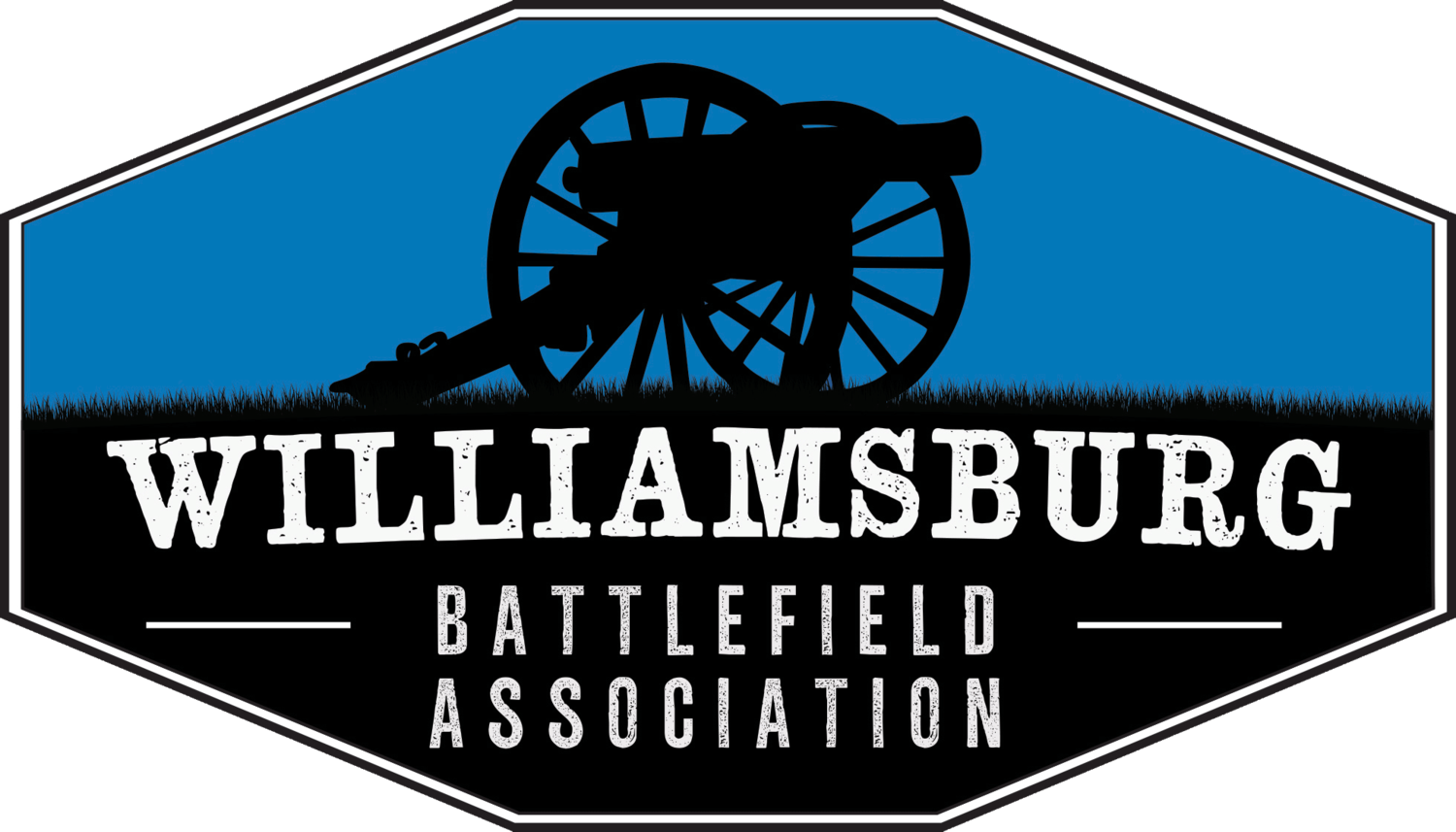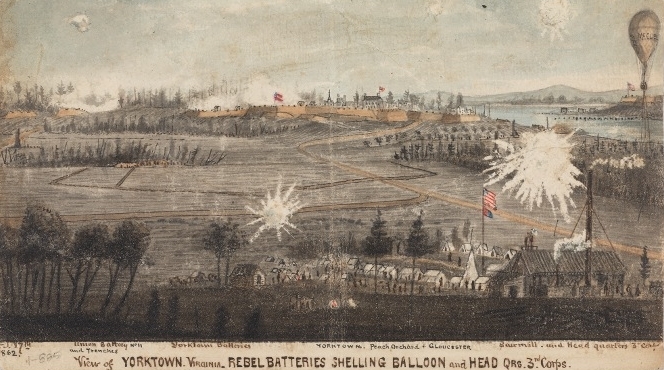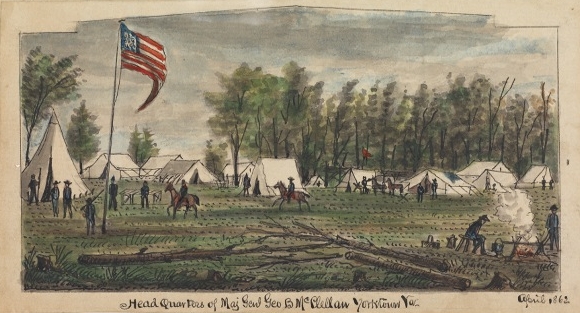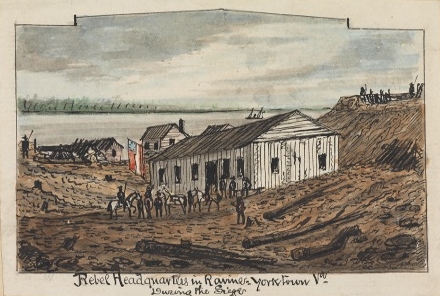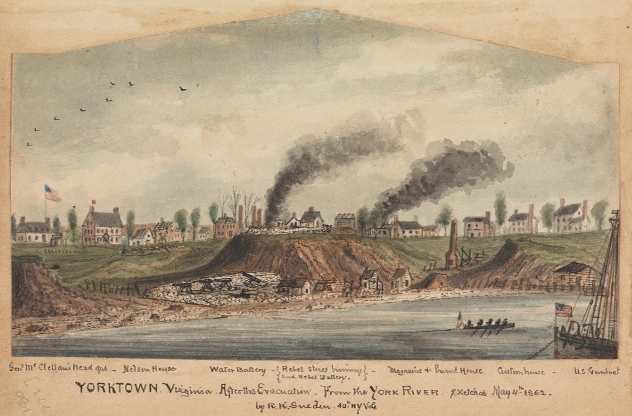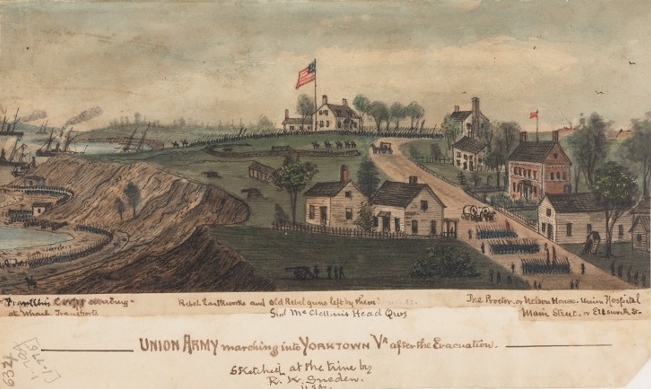“The Battle of Williamsburg has received less importance in history than it has merited.”
Prelude to Battle
The Battle of Williamsburg (May 5, 1862) was the first pitched battle of the Peninsula Campaign, the first large scale offensive by the Union in the Eastern Theater of war. Conceived and led by Major General George B. McClellan, the campaign began in March with a massive amphibious turning movement down the Chesapeake Bay from Washington DC to Union occupied Fort Monroe at the tip of the Virginia Peninsula that is bordered by the York and James Rivers. This move-ment was designed to bypass Confederate defensive positions in Northern Virginia and to quickly seize the Confederate capital in Richmond via the “back door”. Aware of this threat, Confederates built three defensive lines of earthworks across the Peninsula a year earlier. The final line was one mile east of Williamsburg.
Sneden, Robert Knox. "Map of the Lower Peninsula of Virginia, April 1862." Library of Congress, www.loc.gov/item/gvhs01.vhs00076/.
"Siege of Yorktown"
In early April, Union forces proceeding up the Peninsula halted at the Yorktown-Warwick River defensive line, which was manned by severely outnumbered Con-federates under Major General John B. Magruder. Having faulty intelligence and a careful engineer's mind, McClellan determined to lay siege in grandiose style as opposed to assaulting the line and pushing onwards. This decision allowed Con-federates under General Joseph Johnston to reinforce the Peninsula, leading to the month-long, so-called “Siege of Yorktown”.
Slide Images: Robert Knox Sneden Diary, 1861–1865 (Mss5:1 Sn237:1), Virginia Historical Society, Richmond, Va.
Eve of Battle
May 4 - Morning
Dawn on May 4 revealed that Con-federates had pulled back from the Yorktown-Warwick line just before the Union siege bombardment was to commence and were stealing away up the Yorktown and Hampton Roads towards Richmond. Despite being taken completely by surprise, the Union cavalry and artillery's pursuit was aggressive, catching the rearguard of the Confederates just east of Williamsburg. A series of running skirmishes ensued on both roads during the day. At one point, Confederate cavalry under Brig. General J.E.B. Stuart was cut off and forced to proceed up the beaches of the James River.
may 4 - evening
By evening, the Union pursuit had pushed to the historic intersection of the Yorktown and Hampton Roads a mile east of Williamsburg and directly in front of the final Confederate defensive line. Inexplicably, though, Confederates had not manned the Williamsburg line’s 14 redoubts guarding the approach to the town. The arrival of the Union vanguard forced Confederates to rush back from Williamsburg to man the defenses, including massive Fort Magruder, which commanded the single road into Williamsburg. A severe engagement followed, resulting in the Union cavalry and artillery pulling back.
McAlester, Miles D. "Sketch of the Battlefield and Confederate Works in Front of Williamsburg, Va., May 5th 1862." Library of Congress, www.loc.gov/item/99446371/.
During the night as cold rain fell, the Union III and IV Corps of infantry slogged up to Williamsburg under overall command of Brig. General Edwin Sumner since McClellan had determined to remain in Yorktown. The Confederates continued their retrograde movement towards Richmond with Maj. General James Longstreet in the rearguard. Longstreet assigned Brig. General Richard Anderson’s brigade to man the Williamsburg line of defensives and to keep the Union forces at bay.
The Battle
Waud, Alfred R. "General Hooker's Division Engaging the Enemy at the Battle of Williams-burg." Published in Harper's Weekly May 24, 1862. Library of Congress. www.loc.gov/pictures/item/2004660492/.
May 5 - morning phase
In the morning, Union Brig. General Joseph Hooker moved his division of the III Corps into position on the Hampton Road in front of the Williamsburg defensive line. He pushed the Southern pickets back to their earthworks, opened com-munication with the Union IV Corps on the Yorktown Road, and initiated a brisk bombardment on several of the Confederate redoubts. With this opening action, Confederate Brig. General Cadmus Wilcox’s brigade was sent back from Wil-liamsburg and audaciously moved from the strong defensive line to attack Hooker’s left flank through a deep ravine to the south of Fort Magruder. For the next six hours, Hooker’s and Longstreet’s divisions fought viciously in the rain, mud, fields barricaded with abatis, and deep forests. Sumner, indecisive in command, did not allow the Union IV Corps to move up and support Hooker’s hard-pressed division. Eventually, the Confederate’s concentrated numbers pushed Hookers’ exhausted division back, capturing his battery of ten artillery pieces and taking command of the Yorktown and Hampton Roads' junction. At this point, the Confederate tide was stopped by the fortuitous arrival and aggressive deployment of Brig. General Philip Kearny’s division of the III Corps coming up the Hampton Road and the engagement of Confederates on the Yorktown Road with Union Brig. General John Peck’s brigade of the IV Corps. Kearny fiercely counterattacked and was able to push Longstreet’s last brigade and elements from Maj. General D.H. Hill’s division, which had been recalled to add support, back into the Confederate defensive works.
Waud, Alfred R. "General Hancock's Brigade Charging the Rebels at the Battle of Williams-burg." Engraving. Published in Harper's Weekly May 24, 1862. Library of Congress, www.loc.gov/pictures/item/2004660493/.
may 5 - afternoon phase
Meanwhile, a brigade and battery of ten guns under Union Brig. General Winfield S. Hancock had firmly establishment itself on the Confederate left flank and threatened to roll it up. Hancock’s ability to take this position unopposed was the result of a careless oversight by the Confederate command. During the replacement of troops manning the redoubts of the Williamsburg line after the fighting on the 4th, the five redoubts on the northern end of the line were left completely un-occupied. Union headquarters was informed of the oversight and strategic opportunity by runaway slaves. Union Brig. General William “Baldy” Smith (Hancock’s divisional commander) begged Brig. General Sumner for additional troops to enable Hancock to mount an aggressive attack, but the request was denied. Confederates realized their mistake and sent Brig. General Jubal Early's brigade of fresh troops from D.H. Hill’s command to attack Hancock’s forces. With dusk arriving, Early commenced his movement through deep woods which caused his regiments to become separated and offline. The 24th Virginia exited the woods alone and immediately attacked. Of the other three regiments, only the 5th North Carolina found its way out of the woods and joined in the attack. The Confederates were ruthlessly repulsed, and the day's fighting effectively came to an end at dusk.
The Outcome
During the night of May 5, the Confederates withdrew from the Williamsburg defensive line, through the town, and up Stage Road (present day Richmond Road) to Richmond. Union forces occupied both the battlefield and Williamsburg on May 6. The dead from both sides were buried on the battlefield and the wounded were ministered to in barns, churches, public buildings, private homes, and at the College of William and Mary. The battle produced over 4,000 casualties (more than the First Battle of Manassas) and, while both sides claimed victory, is considered by historians to have been indecisive and a tactical draw. Though claimed by many today to just have been a large skirmish, the Battle of Williamsburg was tenaciously fought and was written and talked about by participants on both sides for a long-time afterwards. At Williamsburg, largely green troops learned how to fight, and soon-to-be well known commanders learned how to lead. Seven Medals of Honor were earned on May 5, and several participants earned their sobriquets at Williams-burg: “Fighting” Joe Hooker, “The Gallant” John Pelham of Stuart’s Horse Cavalry fame, and Hancock “The Superb”.
